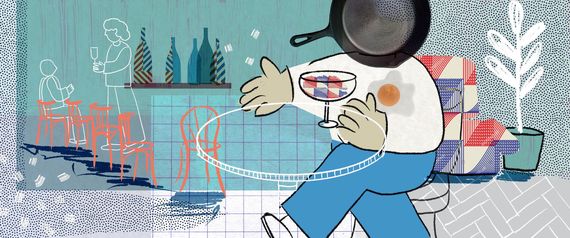Sun Feb 28 2021 · 6 min read
Listening to Imagine: A Post-Crisis Exhibition Attempting to Reimagine Armenia’s Future
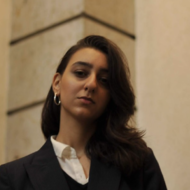
By Liana Sahakyan

Illustration by Armine Shahbazyan.
What is the function of art during and after a crisis, such as a global pandemic or war? Many today are asking if art can still help us make sense of reality after our experiences in 2020. Hit by a global pandemic and the devastatingly tragic war in Artsakh, Armenia – ironically – seems to be the “perfect” place where these questions can be thoroughly sounded.
In socially, politically and culturally challenging situations, artists become activists and try to use their art to have a direct impact on their crisis-laden reality. We know that, throughout history, art has played an active role in various movements that have defined entire historical eras. Transcending their normative status as an object of aesthetic enjoyment, politically-engaged artworks strive to raise awareness about difficult questions and instigate a process of reflection in the viewer.
The ongoing debacles in Armenia, and in the region at large, are forcing old ideas about the future to crumble, making way for as yet undefined horizons. It is in this process that contemporary art tries to intervene in order to create new spaces for imagining the future. The exhibition Listening to Imagine, which opened at Dalan Art Gallery in Yerevan on December 25, 2020, aimed to sketch out what those new spaces might be.
In the words of the exhibition’s curator Eva Khachatryan, Listening to Imagine is a direct address to the future by the very fact of its existence. Inviting 18 artists from Armenia and two from Kazakhstan and Belarus to contribute new works, Khachatryan purposefully selected practitioners who have regularly engaged in activism as part of their creative practice.
According to Khachatryan, the exhibition acted as a utopic ground for these artists to gather together, exchange ideas and avoid falling into the abyss of trauma. During the pandemic and the war, loneliness, loss and despair were the dominant experiences that defined Armenian society. That is why Khachatryan emphasized the importance of returning to a physical and shared space for this exhibition as a means of materializing the utopian projections of the artists. Thus, Listening to Imagine became a platform where ideas about possible utopias could be contemplated together. In a sense, the very fact this small show was featured felt “utopian” in and of itself after the pandemic lockdowns, months of self-isolation and the devastations of war.
Despite the fact that contemporary art is often open-ended and philosophically ambivalent, the material art-objects in this exhibition gave a tangible sense of the artists' utopic proposals. Many of these ideas revolve around the issue of how to restore a sense of purpose and “truth” following the cataclysmic events of 2020. As stated by Khachatryan, the war happened not only on the actual front line, but also in the media, which pushed the Armenian public to adopt new forms of communication and exchange. Drawing on the virtual lifestyles engendered by the pandemic, the digital artworks in the show attempt to distance the viewer from this “new normal,” and make us critically reflect on the all-consuming power of mass media and how technology colonizes our day-to-day lives. Featuring the repetitive act of what seems like laundry in a lake, Grigor Muradyan’s video performance Son of the Sun makes a dryly humorous use of the digital medium to question how our current lifestyles have become scattered between the virtual and the crisis-laden reality. Muradyan was inspired by ancient Egyptian rituals, as well as the restrictions imposed by COVID-19, to reflect upon the meaning of human existence through the representation of a seemingly endless menial task.
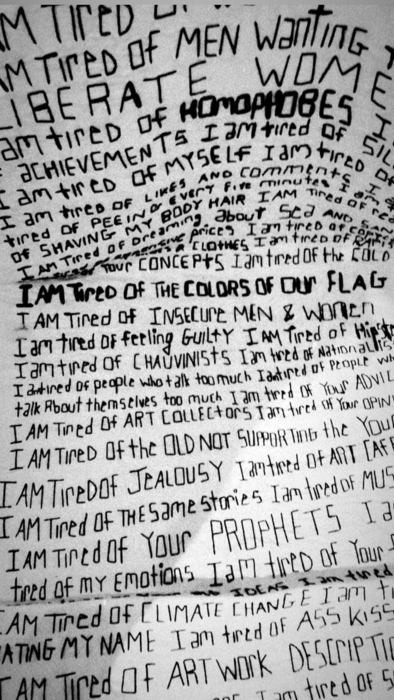
Valentina Maz, We Are All Tired.
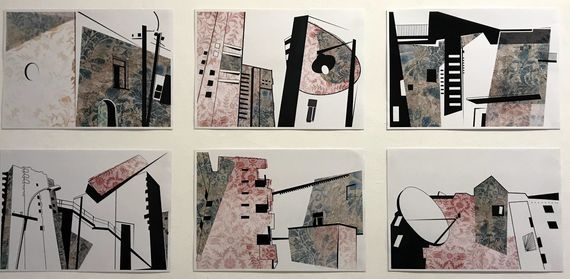
Lusine Talalyan, digital drawings.

Milena Adamyan, How to Be.
also read
It should be noted, however, that the exhibition, in general, suggests a desire to move away from the digital realm, while also thinking about ways to balance the online experience as a constructive rather than destructive aspect of our lives. Turning the virtual into a medium for art appears to be one of the best ways to achieve this balance.
One of the more striking aspects of the exhibition is the way it brought together a diversity of mediums – from ceramics to video and interactive performances. This variety can be seen as a metaphor for the multitude of viewpoints that are quickly emerging in post-war Armenia. Hence, the even coexistence of parallel realities offered by the individual artists becomes the key proposal of this show. Regardless of size or type, none of the works try to make grand statements that would overwhelm their neighbors. Rather, the assembly works because each artwork appears to complement one another.
In her deeply personal piece We Are All Tired, the artist Valentina Maz chose to express the collective anxieties about the present by embroidering her feelings on a long piece of fabric. Maz, an Egyptian-Armenian living in Yerevan, turns the time-consuming process of embroidery into a globally-relevant statement about the pain of the interminable wait for a better future. As she claims in her artist text, “humanity is tired physically, emotionally and mentally... Everything has been multiplied and has become too much to handle, leaving humans as victims of larger forces than themselves. I see humanity as nothing more than an army of broken hearts and aching souls, desperately searching for fulfilment.”
Maz elaborated that the text appearing on her eight-meter long embroidery reflects the exhaustion and the confusion of ordinary individuals from the relentless barrage of global crises. Stretching time, the laborious practice behind this artwork was perhaps a way of coming to terms with new realities and offering a fragile hope in the power of art to heal and help us make sense of the chaos.
Another artist, Lusine Talalyan, attempted to critically reimagine Yerevan's architecture by pulling apart, defragmenting and feminizing its phallic, masculine traits in her digital drawings. Using soft organic lines, pink and green pastel tones, Talalyan searches for ways to defamiliarize ubiquitous architectural spaces and unlock a sense of freedom by queering the patriarchal infrastructures and the mercantile rhetoric of 21st century urban development. In the words of the artist, her digital prints want to "bring the inner side out and to change the landscapes of the city by adding to the facades of the houses such [interior] elements like wallpaper. It is also about the voyeuristic feeling that everybody could have by looking to the windows and guessing who is living there and what kinds of lives they have.” Hence, Talalyan brings forth an oppositional perspective and makes way for the construction of a new future by taking “chaos” as a productive starting point.
Milena Adamyan's photo-collage, How to Be, is another work in the exhibition that echoes this feminist intention. Adamyan's self-portraits show herself surrounded by irreverent texts that call the viewer to rebel against societal expectations of how to be a “proper” woman.
The disparate voices and visions of these artworks offer an image of a post-crisis reality, where highly individual experiences are fostered and allowed to entangle with one another, because the future that they imagine is much more dynamic, open-ended and not fixed in any concrete or dominant ideology. What unites them is the sense of common purpose indicated by the title of the show – the importance of listening to one another and the vital need to keep imagining better ways of being together.
The necessity of having shared, democratic and physical spaces outside of the digital domain where unexpected encounters (with art and people) could happen and critical dialogues can flourish is perhaps the most tangible proposition of this exhibition. It seems to indicate that local contemporary art is, finally, letting go of its reluctance to contemplate the future. At the very least, it is reassuring to see these works as an invitation to collectively meditate and propose new ways of dealing with our fragile grip on reality.
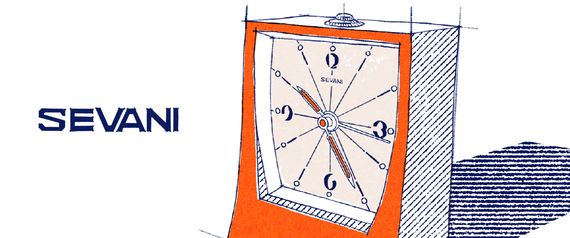
Notes From a Future Museum: Time-Keepers
By Vigen Galstyan
Vigen Galstyan explores the humble charm of Soviet Armenian mechanical clocks in this first instalment of a series of articles about Armenia’s not-too-distant past as a major producer of everyday consumer goods and a hot spot for industrial design in the USSR.

